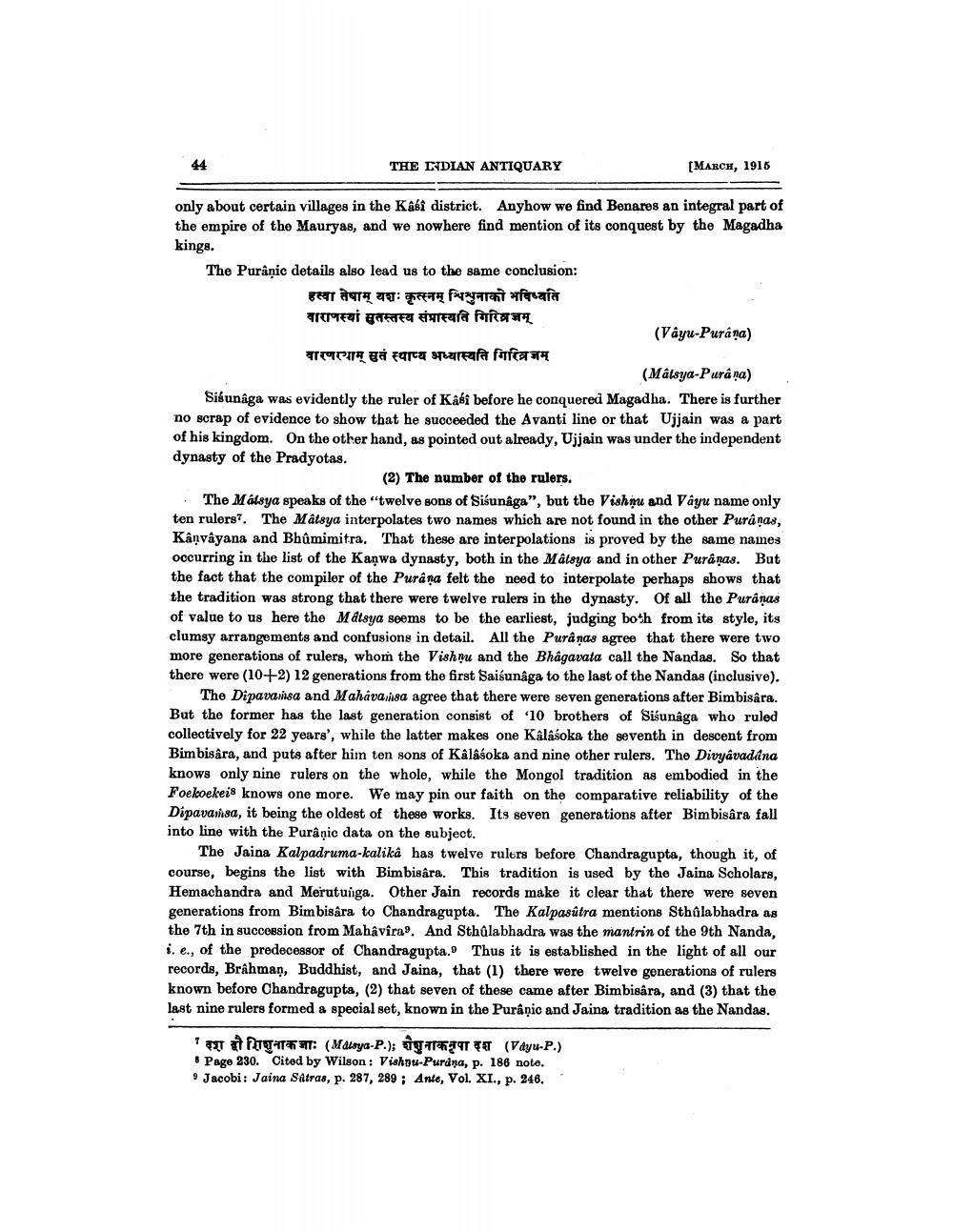________________
44
THE KIDIAN ANTIQUARY
(MARCH, 1915
only about certain villages in the Kabi district. Anyhow we find Benares an integral part of the empire of the Mauryas, and we nowhere find mention of its conquest by the Magadha kings. The Purânic details also lead us to the same conclusion:
हवा तेषाम् यशः कृत्स्नम् विभुनाको भविष्यति वाराणस्यां सतस्तस्य संमास्यति गिरिव्रजम्
(Vayu-Purana) वारणरयाम् सुतं स्थाप्य अध्यास्थति गिरिव्रजम्
(Matsya-Pura na) Sisunaga was evidently the ruler of Kâbî before he conquered Magadha. There is further no scrap of evidence to show that he succeeded the Avanti line or that Ujjain was a part of his kingdom. On the other hand, as pointed out already, Ujjain was under the independent dynasty of the Pradyotas.
(2) The number of the rulers. • The Matsya speaks of the "twelve sons of Siśunâga", but the Vishnu and Vayu name only ten rulers. The Matsya interpolates two names which are not found in the other Puranas, Kâņvâyana and Bhůmimitra. That these are interpolations is proved by the same names occurring in the list of the Kaņwa dynasty, both in the Matsya and in other Purâņas. But the fact that the compiler of the Purana felt the need to interpolate perhaps shows that the tradition was strong that there were twelve rulers in the dynasty. Of all the Puranas of value to us here the Matsya seems to be the earliest, judging both from its style, its clumsy arrangements and confusions in detail. All the Pura nas agree that there were two more generations of rulers, whom the Vishnu and the Bhagavata call the Nandas. So that there were (10+2) 12 generations from the first Saisunaga to the last of the Nandas (inclusive).
The Dipavassa and Mahava-isa agree that there were seven generations after Bimbisára. But the former has the last generation consist of '10 brothers of Siśunâga who ruled collectively for 22 years', while the latter makes one Kalásoka the seventh in descent from Bim bisara, and puts after him ten sons of Kâlâśoka and nine other rulers. The Divyavadana knows only nine rulers on the whole, while the Mongol tradition as embodied in the Foekoekeis knows one more. We may pin our faith on the comparative reliability of the Dipavainsa, it being the oldest of these works. Its seven generations after Bimbisâra fall into line with the Purânic data on the subject.
The Jaina Kalpadruma-kalika has twelve rulers before Chandragupta, though it, of course, begins the list with Bimbisára. This tradition is used by the Jaina Scholars, Hemachandra and Merutunga. Other Jain records make it clear that there were seven generations from Bim bisâra to Chandragupta. The Kalpasútra mentions Sthõlabhadra as the 7th in succession from Mahavira). And Sthûlabhadra was the mantrin of the 9th Nanda, i. e., of the predecessor of Chandragupta.. Thus it is established in the light of all our records, Brahman, Buddhist, and Jaina, that (1) there were twelve generations of rulers known before Chandragupta, (2) that seven of these came after Bimbisára, and (3) that the last nine rulers formed a special set, known in the Purâņic and Jaina tradition as the Nandas.
TOT TATT: (Matsya-P.); agarT TET (Vayu-P.) • Page 230. Cited by Wilson: Vishnu-Purana, p. 186 note. 9 Jacobi: Jaina Satras, p. 287, 289; Ante, Vol. XI, p. 246.




